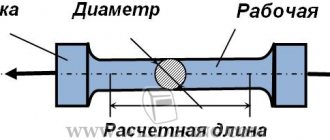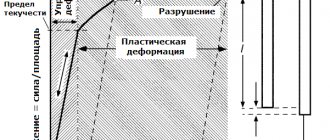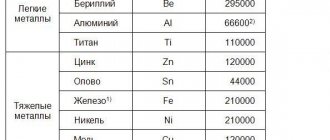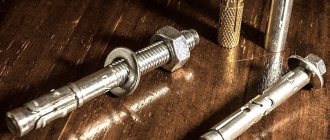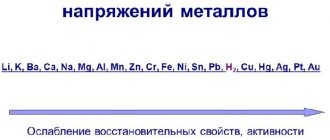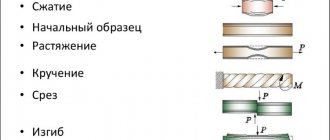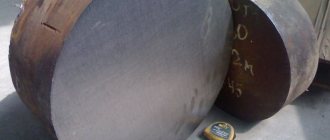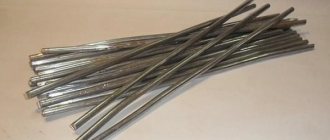Mechanical properties of metals and alloys
The main mechanical properties of metals include strength , toughness , ductility , hardness , endurance, creep, wear resistance. They are the main characteristics of a metal or alloy .
Let's consider some terms used to characterize mechanical properties. Changes in size and shape that occur in a solid under the influence of external forces are called deformations, and the process that causes them is called deformation. Deformations that disappear upon unloading are called elastic, and those that do not disappear after the load is removed are called residual or plastic.
Voltage
is the magnitude of the internal forces that arise in a solid body under the influence of external forces.
The strength of a material is understood as its ability to resist deformation or destruction under the influence of static or dynamic loads. Strength is judged by the characteristics of mechanical properties obtained during mechanical tests. Static strength tests include tension, compression, bending, torsion, and indentation. Dynamic tests include tests for impact strength, endurance and wear resistance. Elasticity is the ability of materials to deform elastically, and plasticity is the ability to deform plastically without destruction.
Viscosity
- this is a property of a material that determines its ability to absorb mechanical energy with a gradual increase in plastic deformation until the destruction of the material. Materials must be both durable and ductile.
Hardness
is the ability of a material to resist the penetration of other bodies into it.
Endurance
- this is the ability of a material to withstand, without collapsing, a large number of repeatedly variable loads.
Wear resistance
is the ability of a material to resist surface destruction under the influence of external friction.
Creep
- this is the ability of a material to slowly and continuously plastically deform (crawl) under constant stress (especially at high temperatures).
The behavior of some metals (for example, annealed steel) under tensile testing is shown in Fig. 3
. As the load increases, processes of elastic deformation first develop in the metal, and the elongation of the sample is insignificant. Then plastic flow of the metal is observed without increasing stress; this period is called fluidity. The stress at which the sample continues to deform without a noticeable increase in load is called the yield strength. With a further increase in load, hardening processes (hardening under load) develop in the metal. The highest stress preceding failure of the sample is called the tensile strength.
Rice. 3. Diagram of deformation during tensile testing of metals.
Tense state
- this is the state of a body under the influence of balanced forces, with established elastic equilibrium of all its particles. Residual stresses are stresses that remain in the body after the cessation of external forces, or that arise during rapid heating and cooling if the linear expansion or shrinkage of metal layers and body parts occurs unevenly.
Internal stresses are formed during rapid cooling or heating in temperature zones of transition from the plastic to elastic state of the metal. These temperatures for steel correspond to 400-600°. If the resulting internal stresses exceed the tensile strength, then cracks form in the parts; if they exceed the elastic limit, then warping of the part occurs.
Tensile strength in kg/mm2
is determined on a tensile testing machine as the ratio of the load P in kg required to destroy a standard sample (
Fig. 4, a
) to the cross-sectional area of the sample in mm2.
Rice. 4. Methods for testing the strength of materials: a - tensile; b - bending; c - impact strength; g - for hardness
Bending strength in kg/mm2
is determined by the destruction of the sample, which is installed on two supports (
Fig. 4, b
), loaded in the middle with a concentrated load P.
To establish the plasticity of a material, the relative elongation δ during tension or the deflection ƒ during bending is determined.
Relative elongation δ in %
determined on samples tested for tension. Divisions are applied to the sample (Fig. 4, a) and the distance between them is measured before testing (l0) and after destruction (l) and the elongation is determined
δ = l-lo / lo 100%
The bending deflection in mm is determined using a machine deflection meter, indicating the deflection ƒ formed on the sample at the moment of its destruction (Fig. 4, b).
Impact strength in kgm/cm2 is determined on samples ( Fig. 4, c
), subjected to destruction on a piledriver by the blow of a pendulum retracted to the side. To do this, the work of deformation in kGm is divided by the cross-sectional area of the sample in cm 2.
Brinell hardness (HH) is determined on the cleaned surface of the sample, into which a steel ball is pressed ( Fig. 4, d
) with a diameter of 5 or 10 mm under a corresponding load of 750 or 3000 kg and measure the diameter d of the resulting hole. The ratio of the load in kg to the hole area πd2 / 4 in mm2 gives the hardness number.
Indicators for mechanical properties for the main alloys are given in table. 1
.
Mechanical properties of wrought brasses
E = 105…115 GPa.
| Brass type | Brass grade | State | Tensile strength σв, MPa | Yield strength σт, MPa | Relative elongation δ, % | Hardness HB, MPa |
| Simple | L96, L90 | Soft condition | 240-260 | 120 | 50 | HB 550 |
| Simple | L96, L90 | Solid state | 450-470 | 400 | 2,5 | HB 1350 |
| Aluminum | LAZ60-1-1 | Soft condition | 450 | 200 | 50 | HB 550 |
| Aluminum | LAZ60-1-1 | Solid state | 700 | — | 8 | HB 1700 |
| Tiny | LO90-1 | Soft condition | 240-260 | 85 | 45 | HB 570 |
| Tiny | LO90-1 | Solid state | 520 | 450 | 4,5 | HB 1450 |
| Lead | LS74-3, LS64-2, LS63-3 | Soft condition | 300-400 | 120 | 40-60 | HB 500-700 |
| Lead | LS74-3, LS64-2, LS63-3 | Solid state | 550-700 | 500 | 2-6 | HB 1000-1200 |
| Lead | LS59-1 | Soft condition | 400 | 140 | 45 | HB 900 |
| Lead | LS59-1 | Solid state | 650 | 450 | 16 | HB 1400 |
Mechanical properties of wrought bronzes
E = 92…130 GPa.
| Bronze | State | Tensile strength σв, MPa | Yield strength σт, MPa | Relative elongation δ, % | Hardness HB, MPa |
| BrAMts9-2 | Soft condition | 450 | 200 | 30 | HB 1100 |
| BrAMts9-2 | Solid state | 800 | 500 | 4 | HB 1800 |
| BrAZH9-4 | Soft condition | 450 | 220 | 40 | HB 1100 |
| BrAZH9-4 | Solid state | 700 | 350 | 4 | HB 2000 |
ELASTIC AND PLASTIC DEFORMATION, DESTRUCTION
If the stress applied to the metal sample is not too great, then its deformation turns out to be elastic - as soon as the stress is removed, its shape is restored. Some metal structures are deliberately designed to deform elastically. Thus, springs usually require a fairly large elastic deformation. In other cases, elastic deformation is minimized. Bridges, beams, mechanisms, devices are made as rigid as possible. The elastic deformation of a metal sample is proportional to the force or sum of forces acting on it. This is expressed by Hooke's law, according to which stress is equal to elastic strain multiplied by a constant coefficient of proportionality called the modulus of elasticity: s
=
eY
, where
s
is stress,
e
is elastic strain, and
Y
is the elastic modulus (Young’s modulus).
The elastic moduli of a number of metals are presented in Table. 1. Table1. Modulus of elasticity of metals
| Table 1 | ||||||
| Metal | Tungsten | Iron (steel) | Copper | Aluminum | Magnesium | Lead |
| Young's modulus, 105 MPa | 3,5 | 2,0 | 1,1 | 0,70 | 0,45 | 0,18 |
Using the data from this table, you can calculate, for example, the force required to stretch a steel rod of square cross-section with a side of 1 cm by 0.1% of its length:
Also on topic:
CORROSION OF METALS
F
=
Y
ґ
A
ґD
L
/
L
= 200,000 MPa ґ 1 cm2ґ0.001 = 20,000 N (= 20 kN)
When stresses in excess of its elastic limit are applied to a metal specimen, they cause plastic (irreversible) deformation, resulting in a permanent change in its shape. Higher stresses can cause material failure.
Also on topic:
METALS TESTING
The most important criterion when choosing a metal material that requires high elasticity is the yield strength. The best spring steels have almost the same modulus of elasticity as the cheapest construction steels, but spring steels are able to withstand much greater stresses, and therefore much greater elastic deformations without plastic deformation, because they have a higher yield strength.
The plastic properties of a metallic material (as opposed to the elastic properties) can be changed by alloying and heat treatment. Thus, the yield strength of iron can be increased 50 times using similar methods. Pure iron goes into a state of fluidity already at stresses of the order of 40 MPa, while the yield strength of steels containing 0.5% carbon and several percent of chromium and nickel, after heating to 950 ° C and hardening, can reach 2000 MPa.
When a metallic material is loaded beyond its yield strength, it continues to deform plastically, but becomes harder as it deforms, so that increasing stress is required to further increase the deformation. This phenomenon is called deformation or mechanical hardening (as well as work hardening). It can be demonstrated by twisting or repeatedly bending a metal wire. Strain hardening of metal products is often carried out in factories. Brass sheets, copper wires, and aluminum rods can be cold rolled or cold drawn to the level of hardness required for the final product.
Hardness.
The hardness of a material is its ability to resist plastic deformation. Since tensile tests require expensive equipment and a lot of time, simpler hardness tests are often used. When testing using the Brinell and Rockwell methods, an “indenter” (a tip shaped like a ball or pyramid) is pressed into the metal surface at a given load and loading speed. Then the size of the print is measured (often done automatically) and the hardness index (number) is determined from it. The smaller the imprint, the greater the hardness. Hardness and yield strength are to some extent comparable characteristics: usually, as one increases, the other also increases.
It may seem that in metallic materials maximum yield strength and hardness are always desirable. In fact, this is not the case, and not only for economic reasons (hardening processes require additional costs).
First, materials need to be shaped into various products, and this is usually done using processes (rolling, stamping, pressing) in which plastic deformation plays an important role. Even when processed on a metal-cutting machine, plastic deformation is very significant. If the hardness of the material is too high, then too much force is required to give it the desired shape, as a result of which the cutting tools quickly wear out. This kind of difficulty can be reduced by processing metals at elevated temperatures, when they become softer. If hot processing is not possible, then metal annealing (slow heating and cooling) is used.
Second, as a metal material gets harder, it usually loses its ductility. In other words, a material becomes brittle if its yield strength is so high that plastic deformation does not occur up to those stresses that immediately cause failure. The designer usually has to choose some intermediate levels of hardness and ductility.
